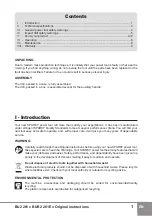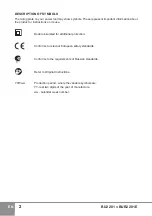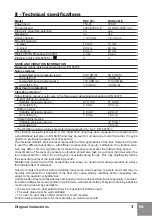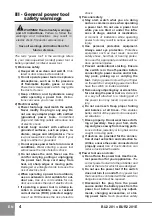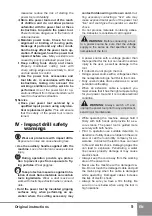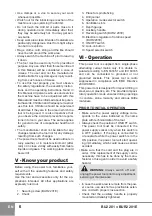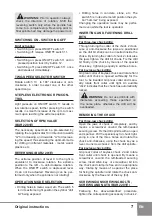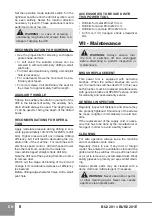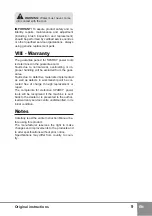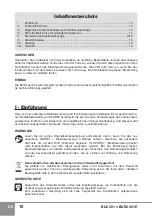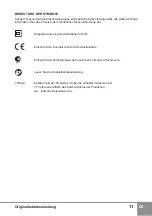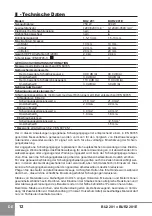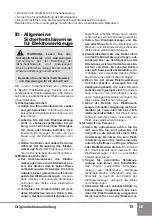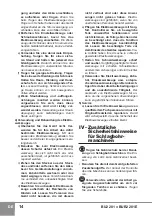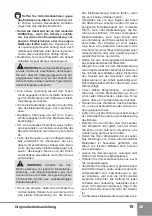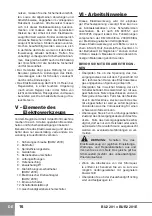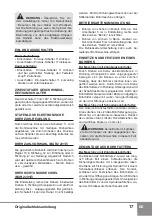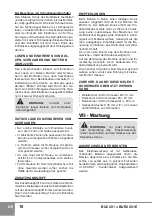
3
Original instructions
EN
II - Technical specifications
Model
BU2 201
BUR2 201E
Power input
750 W
720 W
No load speed
1200/3200 min
–1
0-1200/0-3500 min
–1
Electronic speed pre-selection
no
yes
Reversing
no
yes
Chuck capacity
1.5-13 mm
1.5-13 mm
Max.drill capacity:
in steel
13 mm
13 mm
in wood
40 mm
40 mm
in concrete
20 mm
20 mm
Weight (EPTA Procedure 01/2003)
2.4 kg
2.4 kg
Protection class (EN 60745-1)
II
II
NOISE AND VIBRATION INfORMATION
Measured values determined according to EN 60745
Noise emission
A-weighted sound pressure level L
pA
99.0 dB (A)
99.0 dB (A)
Uncertainty К
pA
3.0 dB (A)
3.0 dB (A)
A-weighted sound power level L
wA
110.0 dB (A)
110.0 dB (A)
Uncertainty К
wA
3.0 dB (A)
3.0 dB (A)
Wear hearing protection!
Vibration emission *
Total vibration values (vector sum in the three axes) determined according to EN 60745:
Impact drilling in concrete
Vibration emission value a
h,ID
21.0 m/s
2
21.0 m/s
2
Uncertainty К
ID
2.0 m/s
2.0 m/s
2
Drilling in steel
Vibration emission value a
h,D
4.0 m/s
2
4.0 m/s
2
Uncertainty К
D
1.8 m/s
2
1.8 m/s
2
Screwing/Unscrewing
Vibration emission value a
h
<2.5 m/s
2
Uncertainty К
1.5 m/s
2
* The vibration emission values are determined according to 6.2.7 EN 60745-1.
The vibration emission level given in this information sheet has been measured in accordance with
a standardised test given in EN 60745 and may be used to compare one tool with another. It may be
used for a preliminary assessment of exposure.
The declared vibration emission level represents the main applications of the tool. However if the tool
is used for different applications, with different accessories or poorly maintained, the vibration emis-
sion may differ. This may significantly increase the exposure level over the total working period.
An estimation of the level of exposure to vibration should also take into account the times when the
tool is switched off or when it is running but not actually doing the job. This may significantly reduce
the exposure level over the total working period.
Maintain the power tool and the accessories and keep your hands warm during operation to reduce
the harmful effect of vibrations.
Dust from material such as paint containing lead, some wood species, minerals and metal may be
harmful. Contact with or inhalation of the dust may cause allergic reactions and/or respiratory dis-
eases to the operator or bystanders.
Certain kinds of dust are classified as carcinogenic such as oak and beech dust especially in conjunc
-
tion with additives for wood conditioning (chromate, wood preservative). Material containing asbestos
must only be treated by specialists.
▪ Where the use of a dust extraction device is possible it shall be used.
▪ The work place must be well ventilated.
▪ The use of a dust mask of filter class P2 is recommended.
Follow national requirements for the materials you want to work with.
Содержание BU2 201
Страница 54: ......



